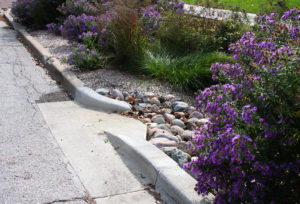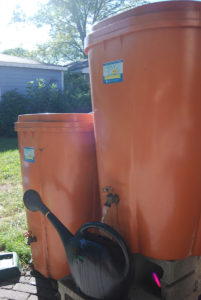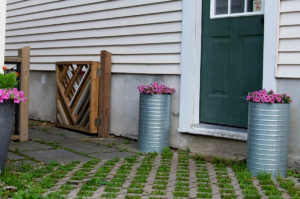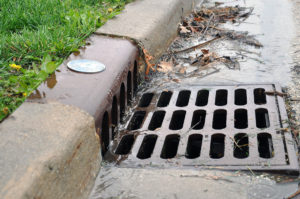Use Rain-Friendly Landscaping
Under natural conditions, most rainfall soaks in where it falls and is naturally filtered by plants and soil. Urbanization has led to an increase in impervious surfaces—hard, paved surfaces that water can’t soak through. Rainfall runs quickly across these impervious surfaces and into nearby streams or storm drains. Along the way, the rainfall, now considered runoff, picks up and carries whatever pollutants it encounters, such as lawn chemicals. There are many simple steps you can take to reduce the amount of water that runs off your property, as well as the amount of pollution it carries. Even if you don’t think you live near water, a storm drain might channel your runoff quickly to a stream. Many of the practices listed below use soil and native plants to naturally absorb and filter runoff. Refer to the Choose the Right Plant for the Right Place section of this website for more information about native plants.
Buffer Strips
Do you have water on your property—a pond, a stream, wetland, even a channel that only flows after a rain? If so, consider buffer strips to protect these waterways from runoff and erosion. Buffer strips are best planted densely with native plants and can either be herbaceous (grasses and wildflowers) or woody (trees and shrubs). Plants in the buffer strip soak up water and filter pollutants before the runoff enters the waterway. The deep roots of the plants hold soil in place, stabilizing banks from erosion. The wider the buffer the better, but even a narrow buffer will help protect the waterway. In addition to water quality benefits, the buffer strip will save you from mowing along the waterway and provide habitat for aquatic wildlife. Can’t afford new plants right now? Simply stop mowing the area along the waterway and see what starts to grow.
Rain Gardens
 A rain garden is simply a shallow depression planted with deep-rooted, water-tolerant native plants. Water from your property is directed toward the garden where it temporarily collects after a rainstorm. Pollutants are filtered naturally as the water soaks into the soil or is absorbed by the plant. Creating a rain garden is not complicated. Place the garden in an area where it can accept runoff from your rooftop, driveway, or lawn. Consider diverting your downspouts or sump pump outlet to the rain garden. Dig a shallow depression with a level base so water can spread out and soak in evenly. A perimeter of turf grass around the rain garden can be maintained as a pre-filter to treat runoff and help prevent soil erosion. If your soil doesn’t drain quickly, consider amending the soil by mixing in sand, gravel, and compost to improve drainage. Select and plant beautiful native plants that are adapted to your soil, moisture, and sun conditions. Spread mulch around the plants to prevent weeds and retain moisture. The rain garden should drain within two days.
A rain garden is simply a shallow depression planted with deep-rooted, water-tolerant native plants. Water from your property is directed toward the garden where it temporarily collects after a rainstorm. Pollutants are filtered naturally as the water soaks into the soil or is absorbed by the plant. Creating a rain garden is not complicated. Place the garden in an area where it can accept runoff from your rooftop, driveway, or lawn. Consider diverting your downspouts or sump pump outlet to the rain garden. Dig a shallow depression with a level base so water can spread out and soak in evenly. A perimeter of turf grass around the rain garden can be maintained as a pre-filter to treat runoff and help prevent soil erosion. If your soil doesn’t drain quickly, consider amending the soil by mixing in sand, gravel, and compost to improve drainage. Select and plant beautiful native plants that are adapted to your soil, moisture, and sun conditions. Spread mulch around the plants to prevent weeds and retain moisture. The rain garden should drain within two days.
ADDITIONAL RESOURCES
Full Sun Rain Garden Brochure
Southern Lake Michigan Rain Garden Manual
Stormwater @ Home: Part Three Rain Gardens
Purdue Rainscaping Program Link
Swales
A swale is similar to a rain garden in that it is a shallow depression planted with native plants. However, a swale conveys water from one point to another. Do you have an area of your property where water flows after a storm? Planting this area as a swale can slow the runoff and reduce erosion.
Rain Barrels
 A rain barrel is a container used to capture water that runs off your roof so that you can reuse it later. The barrels vary in shape, size, and style, but all contain similar features: a hole at the top to allow water in from your downspout, a screen to keep bugs and debris out of the opening, a spigot to release water from the bottom, and an overflow mechanism to divert extra water away from your foundation. The barrels work best when elevated a few feet to allow pressure for releasing the water. Consider threading a soaker hose through your landscaping to automatically irrigate your plants when the spigot is opened. You can purchase a barrel for about $100 or make your own from a recycled barrel. Be sure to use the water around your property—water your plants or wash the car—so that the barrel is empty to collect the next storm.
A rain barrel is a container used to capture water that runs off your roof so that you can reuse it later. The barrels vary in shape, size, and style, but all contain similar features: a hole at the top to allow water in from your downspout, a screen to keep bugs and debris out of the opening, a spigot to release water from the bottom, and an overflow mechanism to divert extra water away from your foundation. The barrels work best when elevated a few feet to allow pressure for releasing the water. Consider threading a soaker hose through your landscaping to automatically irrigate your plants when the spigot is opened. You can purchase a barrel for about $100 or make your own from a recycled barrel. Be sure to use the water around your property—water your plants or wash the car—so that the barrel is empty to collect the next storm.
ADDITIONAL RESOURCES
Critical Area Plantings
Do you have areas on your property where turf grass just won’t grow? Maybe the area is too wet, too dry, too shady, or too steep? Whatever your problem, there are probably native plants adapted to the conditions. Consider replacing poorly growing turf grass with some well-adapted native plants. If a patch of your property is too low and wet to grow turf grass, consider swapping turf with wetland plants that will help take up the water. Woodland wildflowers might love that shady area under your oak tree where the grass won’t grow. Have a crumbling bank or slope? Deep-rooted native plants can stabilize it, preventing erosion.
Minimize Impervious Surfaces
 Minimize the amount of impervious surfaces (hard paved surfaces that water can’t soak through) on your property. Thinking of adding a new patio? Consider using brick pavers. Cracks between the bricks allow water to soak into the ground. Time to replace your driveway? There are materials on the market that look just like regular asphalt or concrete but allow water to soak though, or consider gravel instead. For areas that you can’t make pervious, such as your rooftop, direct the runoff into a rain garden or area where it can soak in rather than to the road or a storm drain.
Minimize the amount of impervious surfaces (hard paved surfaces that water can’t soak through) on your property. Thinking of adding a new patio? Consider using brick pavers. Cracks between the bricks allow water to soak into the ground. Time to replace your driveway? There are materials on the market that look just like regular asphalt or concrete but allow water to soak though, or consider gravel instead. For areas that you can’t make pervious, such as your rooftop, direct the runoff into a rain garden or area where it can soak in rather than to the road or a storm drain.
ADDITIONAL RESOURCES
Don’t Overwater & Reduce Pollutants
 Remember, water that doesn’t soak into the ground or get soaked up by plants can run off of your property, carrying pollutants. Reduce your need for watering and when you do water, do so efficiently, because whatever is on your lawn—fertilizer, pesticide, pet waste—can leave your lawn in this runoff. By being careful with your water use, you can reduce the amount of pollutants that may reach our waterways and help protect your watershed.
Remember, water that doesn’t soak into the ground or get soaked up by plants can run off of your property, carrying pollutants. Reduce your need for watering and when you do water, do so efficiently, because whatever is on your lawn—fertilizer, pesticide, pet waste—can leave your lawn in this runoff. By being careful with your water use, you can reduce the amount of pollutants that may reach our waterways and help protect your watershed.








